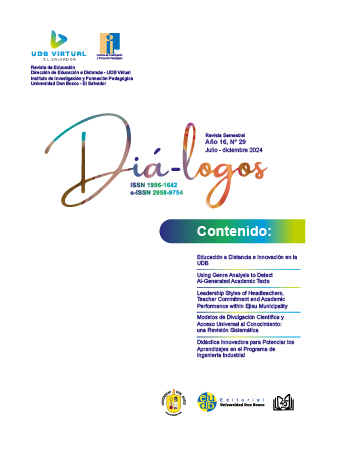Using Genre Analysis to Detect AI-Generated Academic Texts
DOI:
https://doi.org/10.61604/dl.v16i29.377Keywords:
Genre Analysis, AI-generated Texts, Academic Abstracts, Human-AI ComparisonAbstract
This study investigates the distinguishing characteristics between human-written and AI-generated abstracts through genre analysis techniques. The research examined mini-memoir abstracts authored by MA2 students at Faculty of Arts and Humanities, University of Kairouan, Tunisia and compared them to AI-generated abstracts created specifically for this study using ChatGPT. The analysis focused on text function recurrence, specifically the frequency and quality of elements such as purpose statements, methodology, results, and contextualization. Findings revealed that human-written abstracts exhibit a more comprehensive and detailed presentation, emphasizing contextualization and thorough results, while AI-generated abstracts tend to prioritize clear and explicit purpose statements with less depth in results and contextual information. The study highlights the need for targeted teacher training and rigorous assessment criteria to uphold academic integrity and address the challenges posed by AI in scholarly writing.
Downloads
References
American Psychological Association. (2023). Journal article reporting standards (JARS). In Publication Manual of the American Psychological Association (7th ed.). https://www.apa.org/pubs/journals/resources/publishing-policies
Basta, Z. (2024). The intersection of AI-generated content and digital capital: An exploration of factors impacting AI-detection and its consequences [Master's thesis, Uppsala University]. DiVA portal. https://www.diva-portal.org/smash/record.jsf?pid=diva2%3A1870901&dswid=5724
Bhatia, V. K. (1993). Analyzing genre: Language use in professional settings. Routledge.
Brown, T. B., Mann, B., Ryder, N., & Subbiah, M. (2020). Language models are few-shot learners. Proceedings of the 34th Conference on Neural Information Processing Systems (NeurIPS 2020), 1-14.
Darvin, R. (2023). Moving across a genre continuum: Pedagogical strategies for integrating online genres in the language classroom. English for Specific Purposes, 70, 101-115. https://doi.org/10.1016/j.esp.2022.11.004
Dergaa, I., Chamari, K., Zmijewski, P., & Saad, H. B. (2023). From human writing to artificial intelligence generated text: examining the prospects and potential threats of ChatGPT in academic writing. Biology of sport, 40(2), 615-622. https://doi.org/10.5114%2Fbiolsport.2023.125623
Draxler, F., Werner, A., Lehmann, F., Hoppe, M., Schmidt, A., Buschek, D., & Welsch, R. (2024). The AI ghostwriter effect: When users do not perceive ownership of AI-generated text but self-declare as authors. ACM Transactions on Computer-Human Interaction, 31(2), 1-40. https://doi.org/10.1145/3637875
Elkhatat, A. M., Elsaid, K., & Almeer, S. (2023). Evaluating the efficacy of AI content detection tools in differentiating between human and AI-generated text. International Journal for Educational Integrity, 19(1), 17. https://doi.org/10.1007/s40979-023-00140-5
Garib, A., & Coffelt, T. A. (2024). DETECTing the anomalies: Exploring implications of qualitative research in identifying AI-generated text for AI-assisted composition instruction. Computers and Composition, 73, 102869. https://doi.org/10.1016/j.compcom.2024.102869
Gupta, B. P. (2024). Can Artificial Intelligence Only be a Helper Writer for Science?. Science Insights, 44(1), 1221-1227. https://doi.org/10.15354/si.24.re872
Hyland, K. (2000). Disciplinary discourses: Social interactions in academic writing. Longman.
Heracleous, L. (2006). Discourse, interpretation, organization. Cambridge University Press.
Javaid, M., Haleem, A., Singh, R. P., Khan, S., & Khan, I. H. (2023). Unlocking the opportunities through ChatGPT Tool towards ameliorating the education system. BenchCouncil Transactions on Benchmarks, Standards and Evaluations, 3(2), 100115. https://doi.org/10.1016/j.tbench.2023.100115
Kessler, M., & Polio, C. (Eds.). (2023). Conducting genre-based research in applied linguistics: A methodological guide. Taylor & Francis.
Leki, I. (1991). Twenty-five years of contrastive rhetoric: Text analysis and writing pedagogies. Tesol Quarterly, 25(1), 123-143. https://doi.org/10.2307/3587031
Logacheva, E., Hellas, A., Prather, J., Sarsa, S., & Leinonen, J. (2024). Evaluating Contextually Personalized Programming Exercises Created with Generative AI. arXiv preprint arXiv:2407.11994. https://doi.org/10.1145/3632620.3671103
Melliti, M. (in press). AI in MA thesis writing: The use of lexical patterns to study the ChatGPT influence. TESOL International Journal. https://www.tesolunion.org/journal/lists/folder/cMjkufOTBh/
Ortega, L. (2003). Syntactic complexity measures and their relationship to L2 proficiency: A research synthesis of college‐level L2 writing. Applied linguistics, 24(4), 492-518. https://doi.org/10.1093/applin/24.4.492
Sárdi, C. (2023). Exploring the Complexities of L2 English Academic Writing: Towards a Comprehensive Approach to Teaching English for Academic Purposes. Pázmány Papers–Journal of Languages and Cultures, 1(1), 308-323. https://doi.org/10.69706/PP.2023.1.1.18
Sidorkin, A. M. (2024). Embracing chatbots in higher education: the use of artificial intelligence in teaching, administration, and scholarship. Taylor & Francis.
Swales, J. M. (1990). Genre analysis: English in academic and research settings. Cambridge University Press.
Yang, Y., Zhang, L., Xu, G., Ren, G., & Wang, G. (2024). An evidence-based multimodal fusion approach for predicting review helpfulness with human-AI complementarity. Expert Systems with Applications, 238, 121878. https://doi.org/10.1016/j.eswa.2023.121878
Zhang, G. (2023). Authorial stance in citations: Variation by writer expertise and research article part-genres. English for Specific Purposes, 70, 131-147. https://doi.org/10.1016/j.esp.2022.12.002
Downloads
Published
How to Cite
Issue
Section
License

This work is licensed under a Creative Commons Attribution-NonCommercial-NoDerivatives 4.0 International License.









